Analysis of Management Accounting and Budgetary Control Process
VerifiedAdded on 2020/10/22
|8
|2107
|477
Report
AI Summary
This report provides a comprehensive overview of management accounting and budgetary control. It begins by defining management accounting and its role in planning, evaluating, coordinating, and controlling activities using accounting information. The report then details the sequence of the budgetary process, including determining information flow, deciding what to measure, gathering historical data, making projections, and controlling outcomes. It emphasizes the importance of budgeting as a tool for forecasting, decision-making, and resource allocation. The report also discusses various techniques of management accounting such as marginal costing and replacement accounting, and highlights the advantages of budgeting, including improved resource allocation, control of income and expenditure, and systematic problem-solving. Finally, the report addresses the behavioral aspects of budgeting and concludes that both management accounting and budgetary control are essential for organizational success. The report references several academic sources to support its findings.
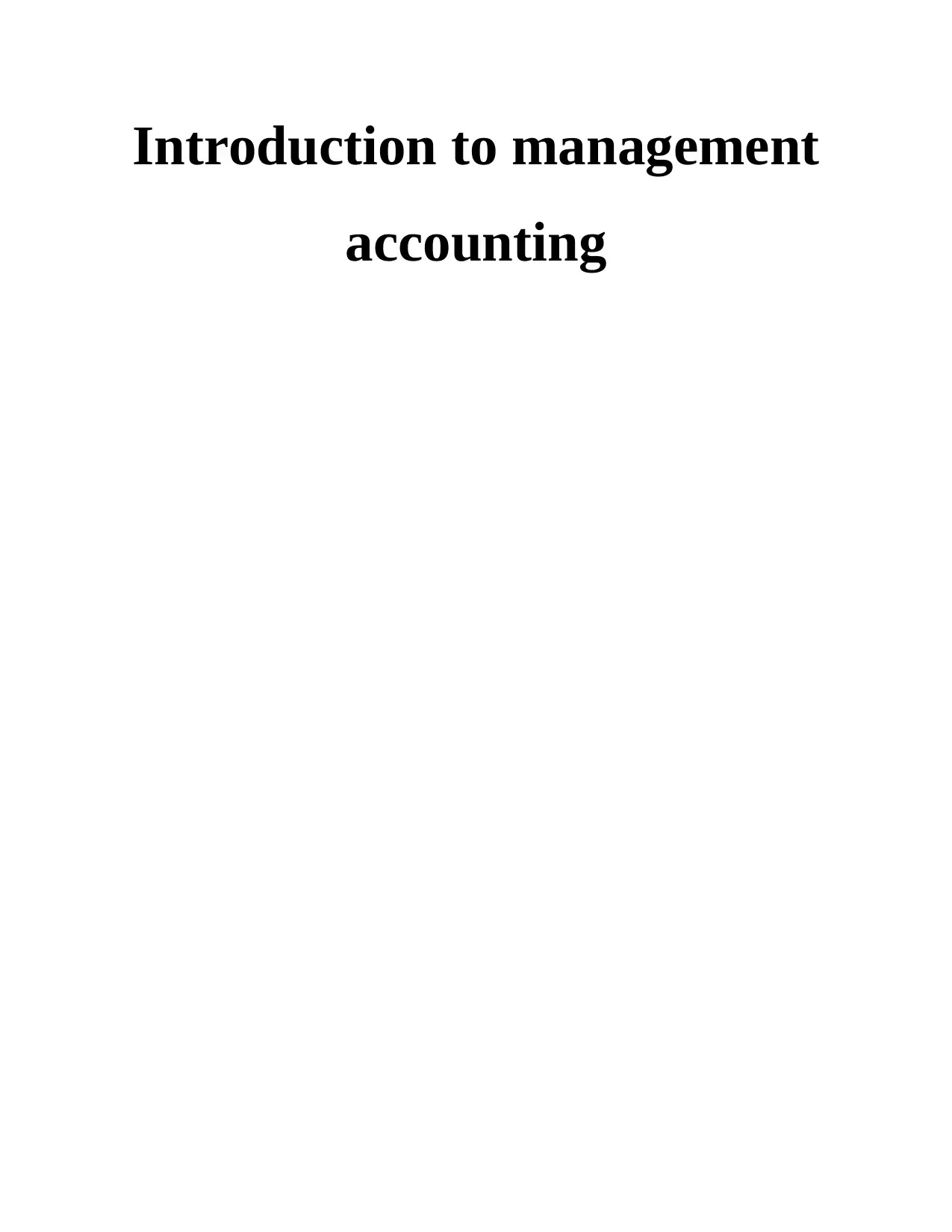
Introduction to management
accounting
accounting
Paraphrase This Document
Need a fresh take? Get an instant paraphrase of this document with our AI Paraphraser
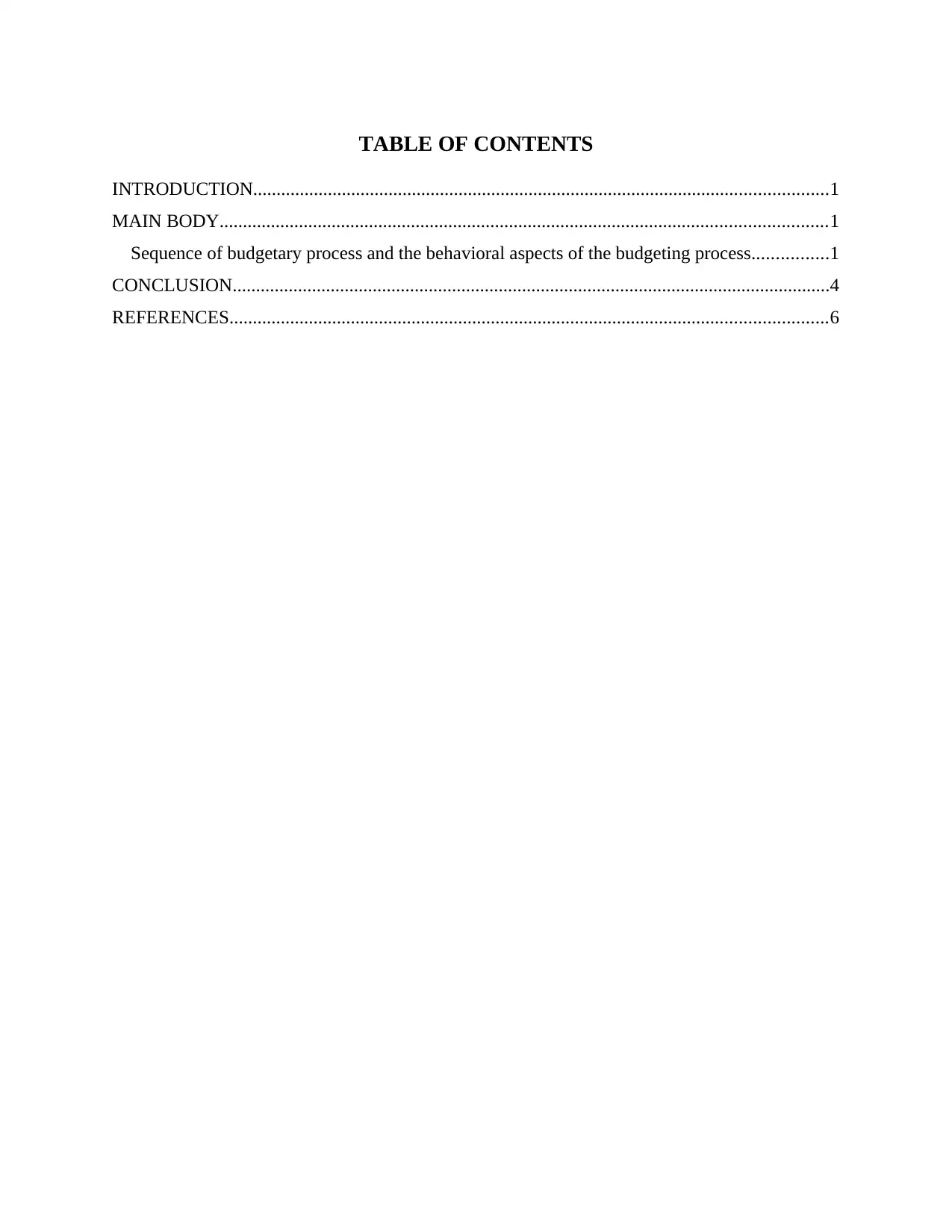
TABLE OF CONTENTS
INTRODUCTION...........................................................................................................................1
MAIN BODY..................................................................................................................................1
Sequence of budgetary process and the behavioral aspects of the budgeting process................1
CONCLUSION................................................................................................................................4
REFERENCES................................................................................................................................6
INTRODUCTION...........................................................................................................................1
MAIN BODY..................................................................................................................................1
Sequence of budgetary process and the behavioral aspects of the budgeting process................1
CONCLUSION................................................................................................................................4
REFERENCES................................................................................................................................6
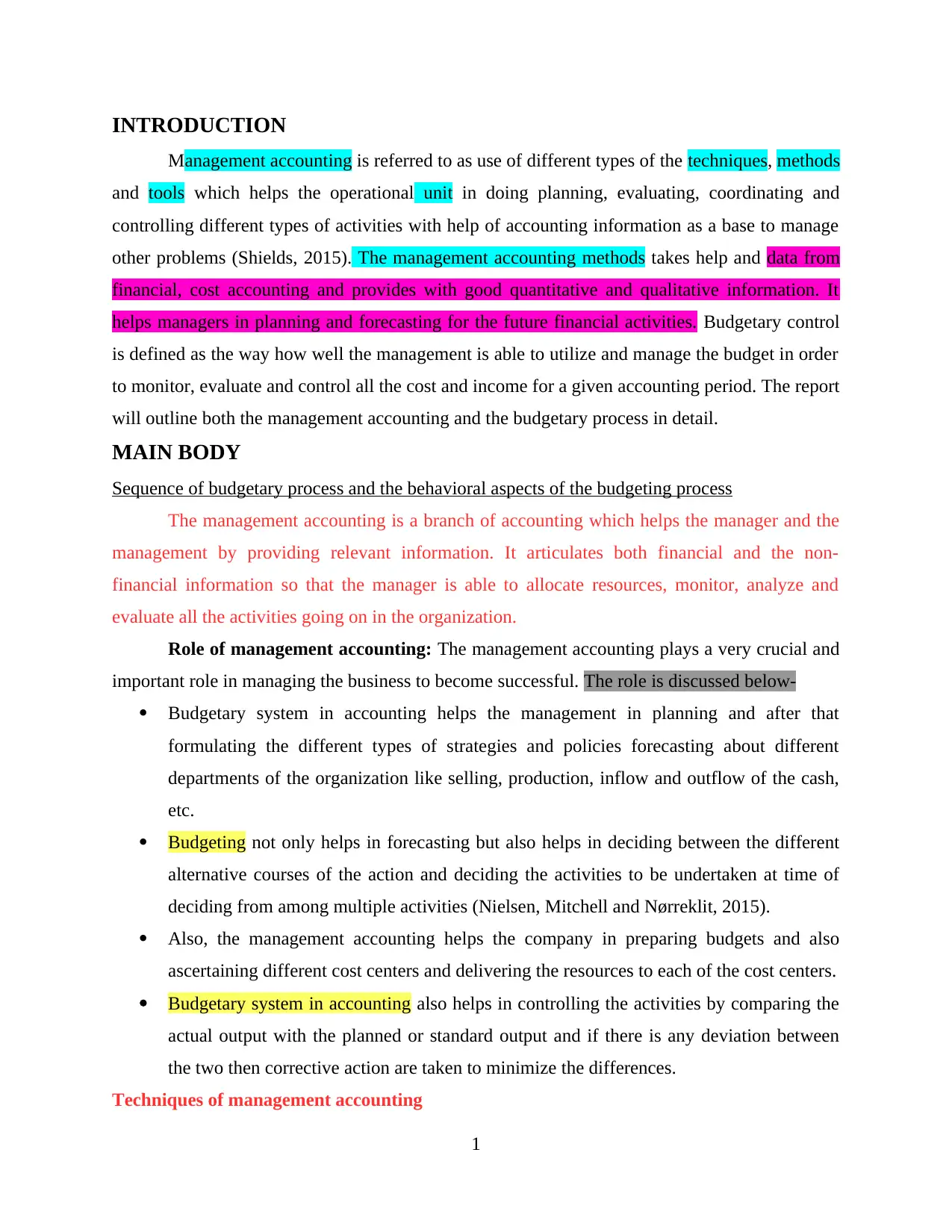
INTRODUCTION
Management accounting is referred to as use of different types of the techniques, methods
and tools which helps the operational unit in doing planning, evaluating, coordinating and
controlling different types of activities with help of accounting information as a base to manage
other problems (Shields, 2015). The management accounting methods takes help and data from
financial, cost accounting and provides with good quantitative and qualitative information. It
helps managers in planning and forecasting for the future financial activities. Budgetary control
is defined as the way how well the management is able to utilize and manage the budget in order
to monitor, evaluate and control all the cost and income for a given accounting period. The report
will outline both the management accounting and the budgetary process in detail.
MAIN BODY
Sequence of budgetary process and the behavioral aspects of the budgeting process
The management accounting is a branch of accounting which helps the manager and the
management by providing relevant information. It articulates both financial and the non-
financial information so that the manager is able to allocate resources, monitor, analyze and
evaluate all the activities going on in the organization.
Role of management accounting: The management accounting plays a very crucial and
important role in managing the business to become successful. The role is discussed below-
Budgetary system in accounting helps the management in planning and after that
formulating the different types of strategies and policies forecasting about different
departments of the organization like selling, production, inflow and outflow of the cash,
etc.
Budgeting not only helps in forecasting but also helps in deciding between the different
alternative courses of the action and deciding the activities to be undertaken at time of
deciding from among multiple activities (Nielsen, Mitchell and Nørreklit, 2015).
Also, the management accounting helps the company in preparing budgets and also
ascertaining different cost centers and delivering the resources to each of the cost centers.
Budgetary system in accounting also helps in controlling the activities by comparing the
actual output with the planned or standard output and if there is any deviation between
the two then corrective action are taken to minimize the differences.
Techniques of management accounting
1
Management accounting is referred to as use of different types of the techniques, methods
and tools which helps the operational unit in doing planning, evaluating, coordinating and
controlling different types of activities with help of accounting information as a base to manage
other problems (Shields, 2015). The management accounting methods takes help and data from
financial, cost accounting and provides with good quantitative and qualitative information. It
helps managers in planning and forecasting for the future financial activities. Budgetary control
is defined as the way how well the management is able to utilize and manage the budget in order
to monitor, evaluate and control all the cost and income for a given accounting period. The report
will outline both the management accounting and the budgetary process in detail.
MAIN BODY
Sequence of budgetary process and the behavioral aspects of the budgeting process
The management accounting is a branch of accounting which helps the manager and the
management by providing relevant information. It articulates both financial and the non-
financial information so that the manager is able to allocate resources, monitor, analyze and
evaluate all the activities going on in the organization.
Role of management accounting: The management accounting plays a very crucial and
important role in managing the business to become successful. The role is discussed below-
Budgetary system in accounting helps the management in planning and after that
formulating the different types of strategies and policies forecasting about different
departments of the organization like selling, production, inflow and outflow of the cash,
etc.
Budgeting not only helps in forecasting but also helps in deciding between the different
alternative courses of the action and deciding the activities to be undertaken at time of
deciding from among multiple activities (Nielsen, Mitchell and Nørreklit, 2015).
Also, the management accounting helps the company in preparing budgets and also
ascertaining different cost centers and delivering the resources to each of the cost centers.
Budgetary system in accounting also helps in controlling the activities by comparing the
actual output with the planned or standard output and if there is any deviation between
the two then corrective action are taken to minimize the differences.
Techniques of management accounting
1
⊘ This is a preview!⊘
Do you want full access?
Subscribe today to unlock all pages.

Trusted by 1+ million students worldwide
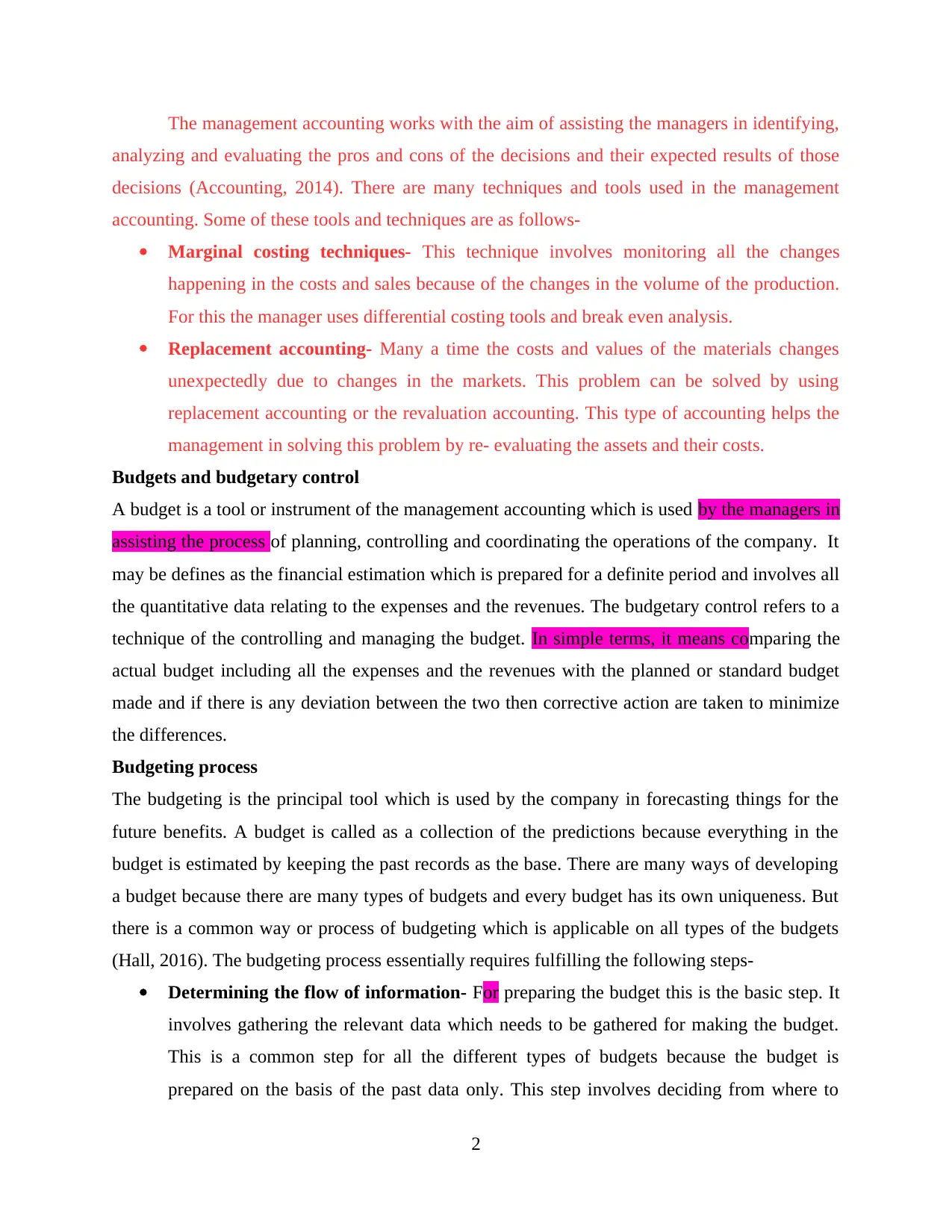
The management accounting works with the aim of assisting the managers in identifying,
analyzing and evaluating the pros and cons of the decisions and their expected results of those
decisions (Accounting, 2014). There are many techniques and tools used in the management
accounting. Some of these tools and techniques are as follows-
Marginal costing techniques- This technique involves monitoring all the changes
happening in the costs and sales because of the changes in the volume of the production.
For this the manager uses differential costing tools and break even analysis.
Replacement accounting- Many a time the costs and values of the materials changes
unexpectedly due to changes in the markets. This problem can be solved by using
replacement accounting or the revaluation accounting. This type of accounting helps the
management in solving this problem by re- evaluating the assets and their costs.
Budgets and budgetary control
A budget is a tool or instrument of the management accounting which is used by the managers in
assisting the process of planning, controlling and coordinating the operations of the company. It
may be defines as the financial estimation which is prepared for a definite period and involves all
the quantitative data relating to the expenses and the revenues. The budgetary control refers to a
technique of the controlling and managing the budget. In simple terms, it means comparing the
actual budget including all the expenses and the revenues with the planned or standard budget
made and if there is any deviation between the two then corrective action are taken to minimize
the differences.
Budgeting process
The budgeting is the principal tool which is used by the company in forecasting things for the
future benefits. A budget is called as a collection of the predictions because everything in the
budget is estimated by keeping the past records as the base. There are many ways of developing
a budget because there are many types of budgets and every budget has its own uniqueness. But
there is a common way or process of budgeting which is applicable on all types of the budgets
(Hall, 2016). The budgeting process essentially requires fulfilling the following steps-
Determining the flow of information- For preparing the budget this is the basic step. It
involves gathering the relevant data which needs to be gathered for making the budget.
This is a common step for all the different types of budgets because the budget is
prepared on the basis of the past data only. This step involves deciding from where to
2
analyzing and evaluating the pros and cons of the decisions and their expected results of those
decisions (Accounting, 2014). There are many techniques and tools used in the management
accounting. Some of these tools and techniques are as follows-
Marginal costing techniques- This technique involves monitoring all the changes
happening in the costs and sales because of the changes in the volume of the production.
For this the manager uses differential costing tools and break even analysis.
Replacement accounting- Many a time the costs and values of the materials changes
unexpectedly due to changes in the markets. This problem can be solved by using
replacement accounting or the revaluation accounting. This type of accounting helps the
management in solving this problem by re- evaluating the assets and their costs.
Budgets and budgetary control
A budget is a tool or instrument of the management accounting which is used by the managers in
assisting the process of planning, controlling and coordinating the operations of the company. It
may be defines as the financial estimation which is prepared for a definite period and involves all
the quantitative data relating to the expenses and the revenues. The budgetary control refers to a
technique of the controlling and managing the budget. In simple terms, it means comparing the
actual budget including all the expenses and the revenues with the planned or standard budget
made and if there is any deviation between the two then corrective action are taken to minimize
the differences.
Budgeting process
The budgeting is the principal tool which is used by the company in forecasting things for the
future benefits. A budget is called as a collection of the predictions because everything in the
budget is estimated by keeping the past records as the base. There are many ways of developing
a budget because there are many types of budgets and every budget has its own uniqueness. But
there is a common way or process of budgeting which is applicable on all types of the budgets
(Hall, 2016). The budgeting process essentially requires fulfilling the following steps-
Determining the flow of information- For preparing the budget this is the basic step. It
involves gathering the relevant data which needs to be gathered for making the budget.
This is a common step for all the different types of budgets because the budget is
prepared on the basis of the past data only. This step involves deciding from where to
2
Paraphrase This Document
Need a fresh take? Get an instant paraphrase of this document with our AI Paraphraser
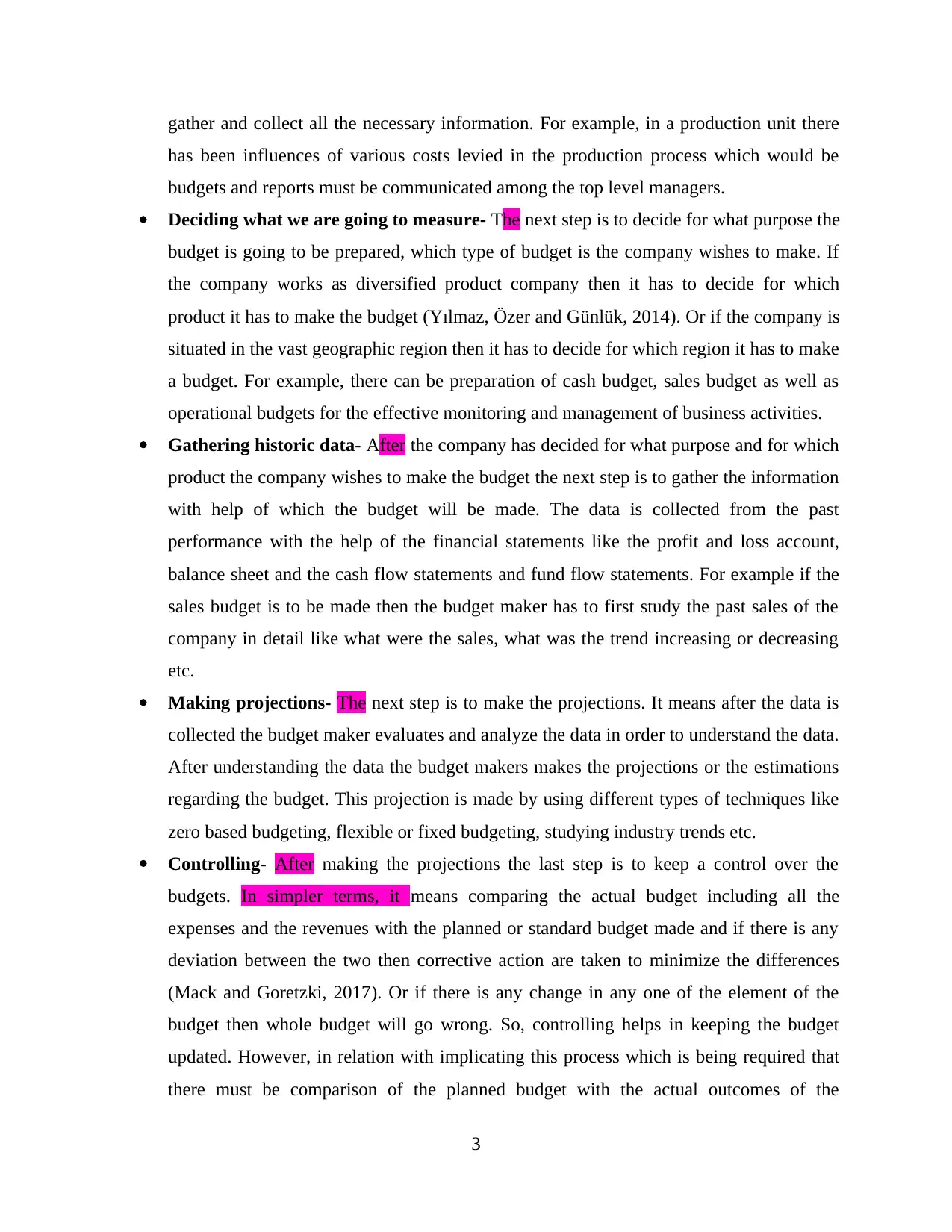
gather and collect all the necessary information. For example, in a production unit there
has been influences of various costs levied in the production process which would be
budgets and reports must be communicated among the top level managers.
Deciding what we are going to measure- The next step is to decide for what purpose the
budget is going to be prepared, which type of budget is the company wishes to make. If
the company works as diversified product company then it has to decide for which
product it has to make the budget (Yılmaz, Özer and Günlük, 2014). Or if the company is
situated in the vast geographic region then it has to decide for which region it has to make
a budget. For example, there can be preparation of cash budget, sales budget as well as
operational budgets for the effective monitoring and management of business activities.
Gathering historic data- After the company has decided for what purpose and for which
product the company wishes to make the budget the next step is to gather the information
with help of which the budget will be made. The data is collected from the past
performance with the help of the financial statements like the profit and loss account,
balance sheet and the cash flow statements and fund flow statements. For example if the
sales budget is to be made then the budget maker has to first study the past sales of the
company in detail like what were the sales, what was the trend increasing or decreasing
etc.
Making projections- The next step is to make the projections. It means after the data is
collected the budget maker evaluates and analyze the data in order to understand the data.
After understanding the data the budget makers makes the projections or the estimations
regarding the budget. This projection is made by using different types of techniques like
zero based budgeting, flexible or fixed budgeting, studying industry trends etc.
Controlling- After making the projections the last step is to keep a control over the
budgets. In simpler terms, it means comparing the actual budget including all the
expenses and the revenues with the planned or standard budget made and if there is any
deviation between the two then corrective action are taken to minimize the differences
(Mack and Goretzki, 2017). Or if there is any change in any one of the element of the
budget then whole budget will go wrong. So, controlling helps in keeping the budget
updated. However, in relation with implicating this process which is being required that
there must be comparison of the planned budget with the actual outcomes of the
3
has been influences of various costs levied in the production process which would be
budgets and reports must be communicated among the top level managers.
Deciding what we are going to measure- The next step is to decide for what purpose the
budget is going to be prepared, which type of budget is the company wishes to make. If
the company works as diversified product company then it has to decide for which
product it has to make the budget (Yılmaz, Özer and Günlük, 2014). Or if the company is
situated in the vast geographic region then it has to decide for which region it has to make
a budget. For example, there can be preparation of cash budget, sales budget as well as
operational budgets for the effective monitoring and management of business activities.
Gathering historic data- After the company has decided for what purpose and for which
product the company wishes to make the budget the next step is to gather the information
with help of which the budget will be made. The data is collected from the past
performance with the help of the financial statements like the profit and loss account,
balance sheet and the cash flow statements and fund flow statements. For example if the
sales budget is to be made then the budget maker has to first study the past sales of the
company in detail like what were the sales, what was the trend increasing or decreasing
etc.
Making projections- The next step is to make the projections. It means after the data is
collected the budget maker evaluates and analyze the data in order to understand the data.
After understanding the data the budget makers makes the projections or the estimations
regarding the budget. This projection is made by using different types of techniques like
zero based budgeting, flexible or fixed budgeting, studying industry trends etc.
Controlling- After making the projections the last step is to keep a control over the
budgets. In simpler terms, it means comparing the actual budget including all the
expenses and the revenues with the planned or standard budget made and if there is any
deviation between the two then corrective action are taken to minimize the differences
(Mack and Goretzki, 2017). Or if there is any change in any one of the element of the
budget then whole budget will go wrong. So, controlling helps in keeping the budget
updated. However, in relation with implicating this process which is being required that
there must be comparison of the planned budget with the actual outcomes of the
3
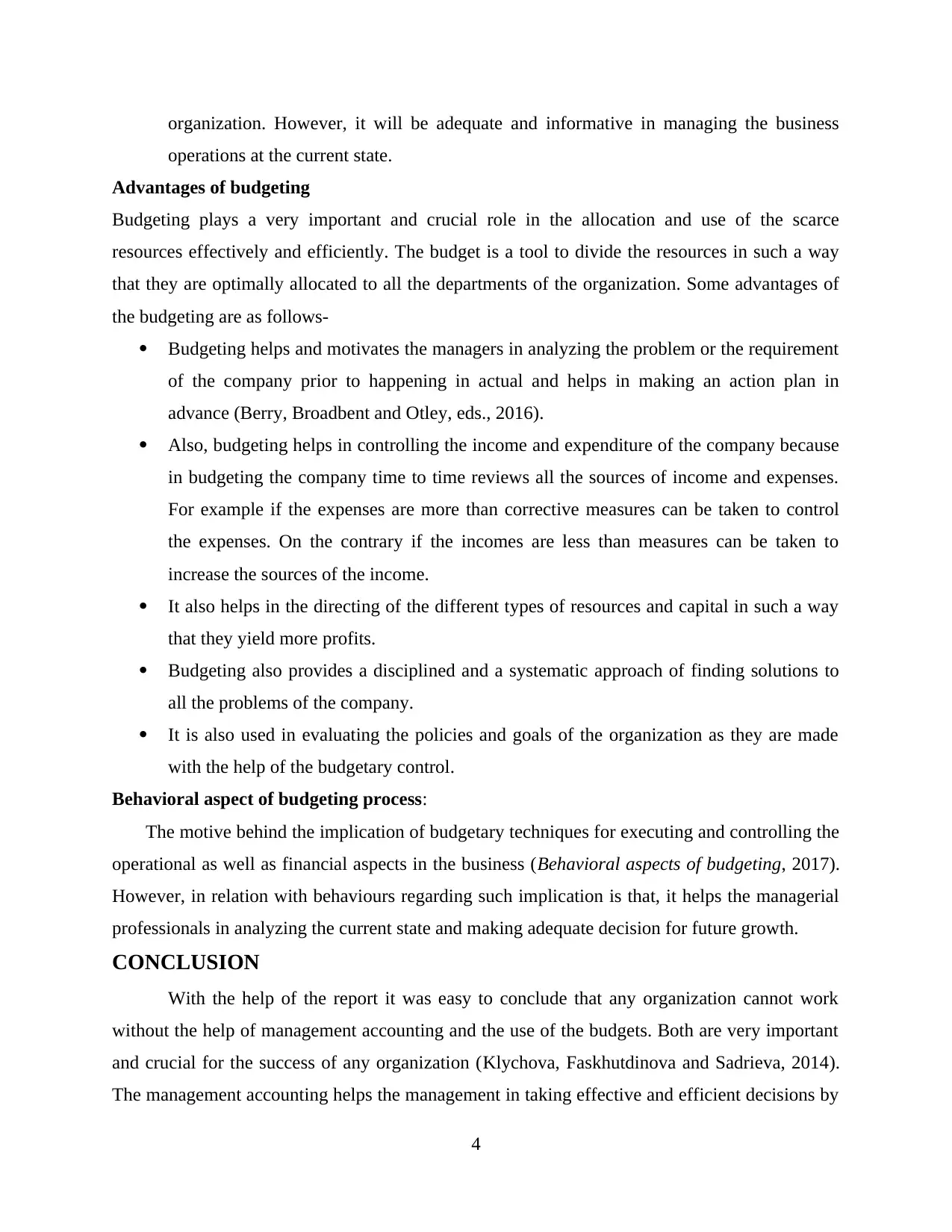
organization. However, it will be adequate and informative in managing the business
operations at the current state.
Advantages of budgeting
Budgeting plays a very important and crucial role in the allocation and use of the scarce
resources effectively and efficiently. The budget is a tool to divide the resources in such a way
that they are optimally allocated to all the departments of the organization. Some advantages of
the budgeting are as follows-
Budgeting helps and motivates the managers in analyzing the problem or the requirement
of the company prior to happening in actual and helps in making an action plan in
advance (Berry, Broadbent and Otley, eds., 2016).
Also, budgeting helps in controlling the income and expenditure of the company because
in budgeting the company time to time reviews all the sources of income and expenses.
For example if the expenses are more than corrective measures can be taken to control
the expenses. On the contrary if the incomes are less than measures can be taken to
increase the sources of the income.
It also helps in the directing of the different types of resources and capital in such a way
that they yield more profits.
Budgeting also provides a disciplined and a systematic approach of finding solutions to
all the problems of the company.
It is also used in evaluating the policies and goals of the organization as they are made
with the help of the budgetary control.
Behavioral aspect of budgeting process:
The motive behind the implication of budgetary techniques for executing and controlling the
operational as well as financial aspects in the business (Behavioral aspects of budgeting, 2017).
However, in relation with behaviours regarding such implication is that, it helps the managerial
professionals in analyzing the current state and making adequate decision for future growth.
CONCLUSION
With the help of the report it was easy to conclude that any organization cannot work
without the help of management accounting and the use of the budgets. Both are very important
and crucial for the success of any organization (Klychova, Faskhutdinova and Sadrieva, 2014).
The management accounting helps the management in taking effective and efficient decisions by
4
operations at the current state.
Advantages of budgeting
Budgeting plays a very important and crucial role in the allocation and use of the scarce
resources effectively and efficiently. The budget is a tool to divide the resources in such a way
that they are optimally allocated to all the departments of the organization. Some advantages of
the budgeting are as follows-
Budgeting helps and motivates the managers in analyzing the problem or the requirement
of the company prior to happening in actual and helps in making an action plan in
advance (Berry, Broadbent and Otley, eds., 2016).
Also, budgeting helps in controlling the income and expenditure of the company because
in budgeting the company time to time reviews all the sources of income and expenses.
For example if the expenses are more than corrective measures can be taken to control
the expenses. On the contrary if the incomes are less than measures can be taken to
increase the sources of the income.
It also helps in the directing of the different types of resources and capital in such a way
that they yield more profits.
Budgeting also provides a disciplined and a systematic approach of finding solutions to
all the problems of the company.
It is also used in evaluating the policies and goals of the organization as they are made
with the help of the budgetary control.
Behavioral aspect of budgeting process:
The motive behind the implication of budgetary techniques for executing and controlling the
operational as well as financial aspects in the business (Behavioral aspects of budgeting, 2017).
However, in relation with behaviours regarding such implication is that, it helps the managerial
professionals in analyzing the current state and making adequate decision for future growth.
CONCLUSION
With the help of the report it was easy to conclude that any organization cannot work
without the help of management accounting and the use of the budgets. Both are very important
and crucial for the success of any organization (Klychova, Faskhutdinova and Sadrieva, 2014).
The management accounting helps the management in taking effective and efficient decisions by
4
⊘ This is a preview!⊘
Do you want full access?
Subscribe today to unlock all pages.

Trusted by 1+ million students worldwide
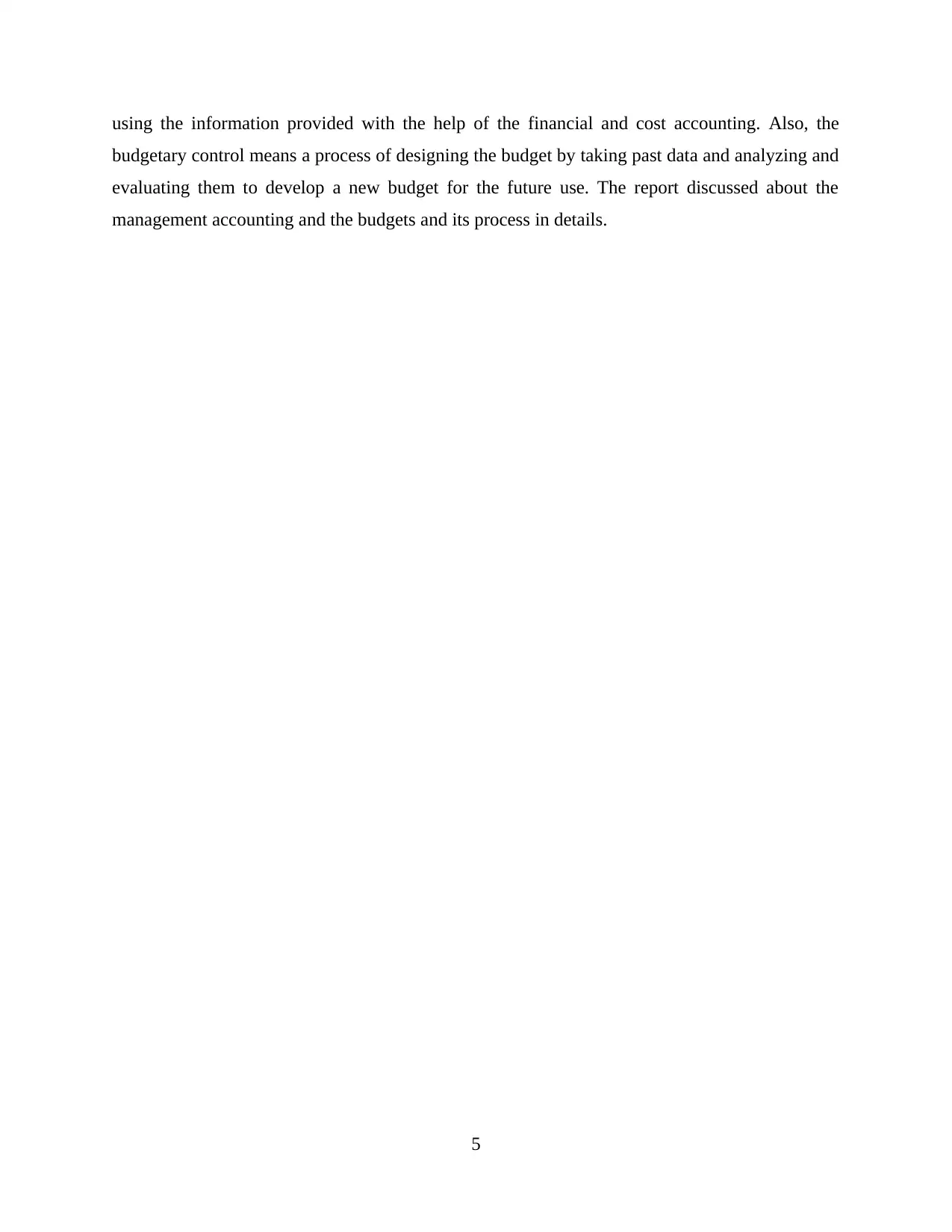
using the information provided with the help of the financial and cost accounting. Also, the
budgetary control means a process of designing the budget by taking past data and analyzing and
evaluating them to develop a new budget for the future use. The report discussed about the
management accounting and the budgets and its process in details.
5
budgetary control means a process of designing the budget by taking past data and analyzing and
evaluating them to develop a new budget for the future use. The report discussed about the
management accounting and the budgets and its process in details.
5
Paraphrase This Document
Need a fresh take? Get an instant paraphrase of this document with our AI Paraphraser
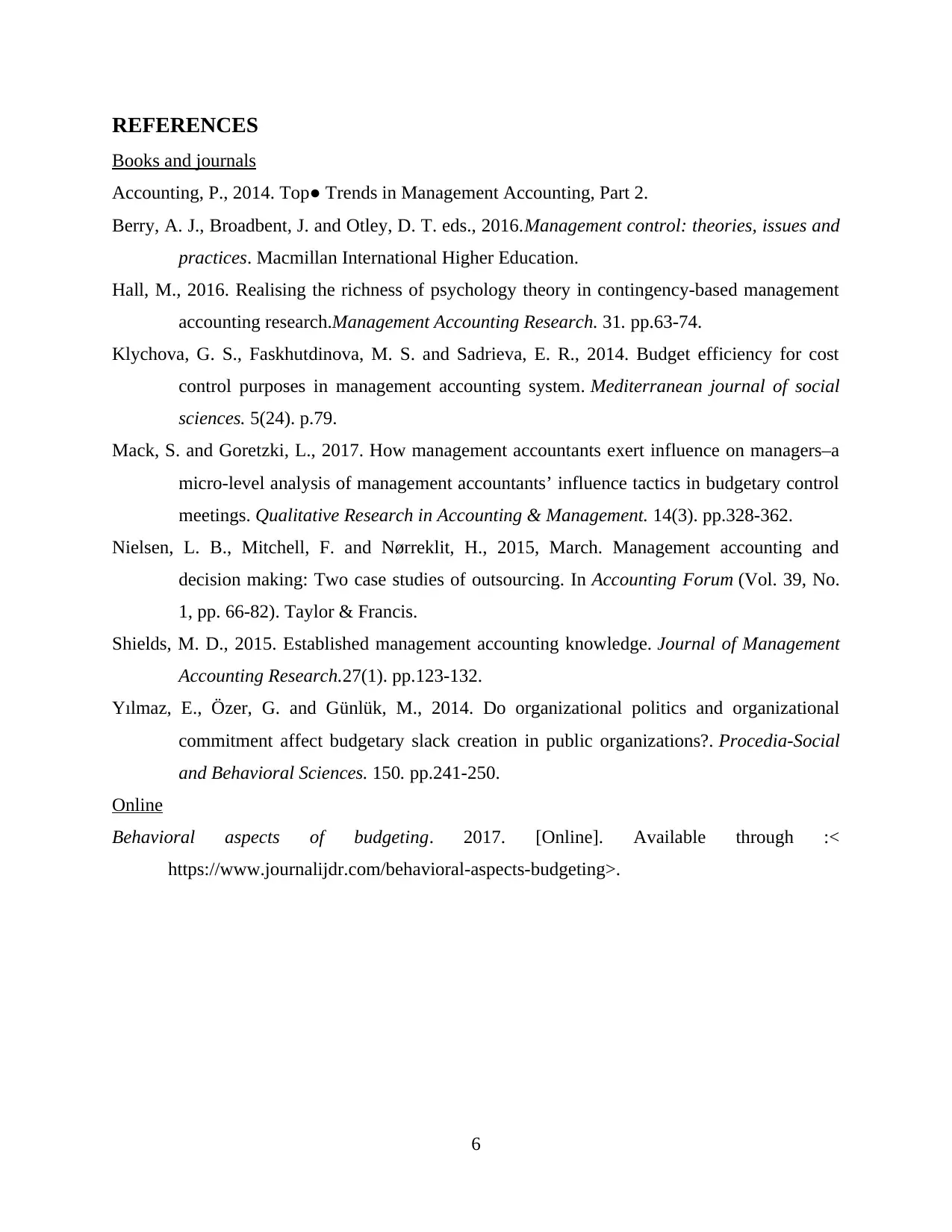
REFERENCES
Books and journals
Accounting, P., 2014. Top● Trends in Management Accounting, Part 2.
Berry, A. J., Broadbent, J. and Otley, D. T. eds., 2016.Management control: theories, issues and
practices. Macmillan International Higher Education.
Hall, M., 2016. Realising the richness of psychology theory in contingency-based management
accounting research.Management Accounting Research. 31. pp.63-74.
Klychova, G. S., Faskhutdinova, М. S. and Sadrieva, E. R., 2014. Budget efficiency for cost
control purposes in management accounting system. Mediterranean journal of social
sciences. 5(24). p.79.
Mack, S. and Goretzki, L., 2017. How management accountants exert influence on managers–a
micro-level analysis of management accountants’ influence tactics in budgetary control
meetings. Qualitative Research in Accounting & Management. 14(3). pp.328-362.
Nielsen, L. B., Mitchell, F. and Nørreklit, H., 2015, March. Management accounting and
decision making: Two case studies of outsourcing. In Accounting Forum (Vol. 39, No.
1, pp. 66-82). Taylor & Francis.
Shields, M. D., 2015. Established management accounting knowledge. Journal of Management
Accounting Research.27(1). pp.123-132.
Yılmaz, E., Özer, G. and Günlük, M., 2014. Do organizational politics and organizational
commitment affect budgetary slack creation in public organizations?. Procedia-Social
and Behavioral Sciences. 150. pp.241-250.
Online
Behavioral aspects of budgeting. 2017. [Online]. Available through :<
https://www.journalijdr.com/behavioral-aspects-budgeting>.
6
Books and journals
Accounting, P., 2014. Top● Trends in Management Accounting, Part 2.
Berry, A. J., Broadbent, J. and Otley, D. T. eds., 2016.Management control: theories, issues and
practices. Macmillan International Higher Education.
Hall, M., 2016. Realising the richness of psychology theory in contingency-based management
accounting research.Management Accounting Research. 31. pp.63-74.
Klychova, G. S., Faskhutdinova, М. S. and Sadrieva, E. R., 2014. Budget efficiency for cost
control purposes in management accounting system. Mediterranean journal of social
sciences. 5(24). p.79.
Mack, S. and Goretzki, L., 2017. How management accountants exert influence on managers–a
micro-level analysis of management accountants’ influence tactics in budgetary control
meetings. Qualitative Research in Accounting & Management. 14(3). pp.328-362.
Nielsen, L. B., Mitchell, F. and Nørreklit, H., 2015, March. Management accounting and
decision making: Two case studies of outsourcing. In Accounting Forum (Vol. 39, No.
1, pp. 66-82). Taylor & Francis.
Shields, M. D., 2015. Established management accounting knowledge. Journal of Management
Accounting Research.27(1). pp.123-132.
Yılmaz, E., Özer, G. and Günlük, M., 2014. Do organizational politics and organizational
commitment affect budgetary slack creation in public organizations?. Procedia-Social
and Behavioral Sciences. 150. pp.241-250.
Online
Behavioral aspects of budgeting. 2017. [Online]. Available through :<
https://www.journalijdr.com/behavioral-aspects-budgeting>.
6
1 out of 8
Related Documents
Your All-in-One AI-Powered Toolkit for Academic Success.
+13062052269
info@desklib.com
Available 24*7 on WhatsApp / Email
![[object Object]](/_next/static/media/star-bottom.7253800d.svg)
Unlock your academic potential
Copyright © 2020–2025 A2Z Services. All Rights Reserved. Developed and managed by ZUCOL.





